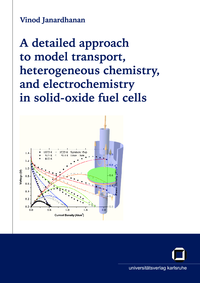Autor "Erik Hatcher"
Se han encontrado 2 Coincidencias
A detailed approach to model transport, heterogeneous chemistry, and electrochemistry in solid-oxide fuel cells
18 Visitas | 25 Descargas | 2015-01-07 17:19:12 | raulito
This dissertation layes out detailed descriptions for heterogeneous chemistry, electrochemistry, and porous media transport models to simulate solid oxide fuel cells (SOFCs). An elementary like heterogeneous reaction mechanism for the steam reforming of CH4 developed in our research group is used throughout this work. Based on assumption of hydrogen oxidation as the only electrochemical reaction and single step electron transfer reaction as rate limiting, a modified Butler-Volmer equation is used to model the electrochemistry. The pertinence of various porous media transport models such as Modified Fick Model (MFM), Dusty Gas Model (DGM), Mean Transport Pore Model (MTPM), Modified Maxwell Stefan Model (MMS), and Generalized Maxwell Stefan Model (GMS) under reaction conditions are studied. All model predictions are compared with experimental observations. In general MFM and DGM predictions are in good agreement with experimental data. Physically realistic electrochemical model parameters are very important for fuel cell modeling. Button cell simulations are carried out to deduce the electrochemical model parameters, and those parameters are further used in the modeling of planar cells. Button cell simulations are carried out using the commercial CFD code FLUENT [1] coupled with DETCHEM [2]. For all temperature ranges the model works well in predicting the experimental observations in the high current density region. However, the model predicts much higher open circuit potentials than that observed in the experiments, mainly due to the absence of coking model in the elementary heterogeneous mechanism leading to nonequilibrium compositions. Furthermore, the study presented here employs Nernst equation for the calculation of reversible potential which is strictly valid only for electrochemical equilibrium. It is assumed that the electrochemical charge transfer reaction involving H2 is fast enough to be in equilibrium. However, the comparison of model prediction with thermodynamic equilibrium reveals that this assumption is violated under very low current densities.

A detailed approach to model transport, heterogeneous chemistry, and electrochemistry in solid-oxide fuel cells
18 Visitas | 25 Descargas | 2015-01-07 17:19:12 | raulito
This dissertation layes out detailed descriptions for heterogeneous chemistry, electrochemistry, and porous media transport models to simulate solid oxide fuel cells (SOFCs). An elementary like heterogeneous reaction mechanism for the steam reforming of CH4 developed in our research group is used throughout this work. Based on assumption of hydrogen oxidation as the only electrochemical reaction and single step electron transfer reaction as rate limiting, a modified Butler-Volmer equation is used to model the electrochemistry. The pertinence of various porous media transport models such as Modified Fick Model (MFM), Dusty Gas Model (DGM), Mean Transport Pore Model (MTPM), Modified Maxwell Stefan Model (MMS), and Generalized Maxwell Stefan Model (GMS) under reaction conditions are studied. All model predictions are compared with experimental observations. In general MFM and DGM predictions are in good agreement with experimental data. Physically realistic electrochemical model parameters are very important for fuel cell modeling. Button cell simulations are carried out to deduce the electrochemical model parameters, and those parameters are further used in the modeling of planar cells. Button cell simulations are carried out using the commercial CFD code FLUENT [1] coupled with DETCHEM [2]. For all temperature ranges the model works well in predicting the experimental observations in the high current density region. However, the model predicts much higher open circuit potentials than that observed in the experiments, mainly due to the absence of coking model in the elementary heterogeneous mechanism leading to nonequilibrium compositions. Furthermore, the study presented here employs Nernst equation for the calculation of reversible potential which is strictly valid only for electrochemical equilibrium. It is assumed that the electrochemical charge transfer reaction involving H2 is fast enough to be in equilibrium. However, the comparison of model prediction with thermodynamic equilibrium reveals that this assumption is violated under very low current densities.
Contribuir
Usted puede contribuir con Libros UCLV, es importante para nosotros su aporte..
Contribuir